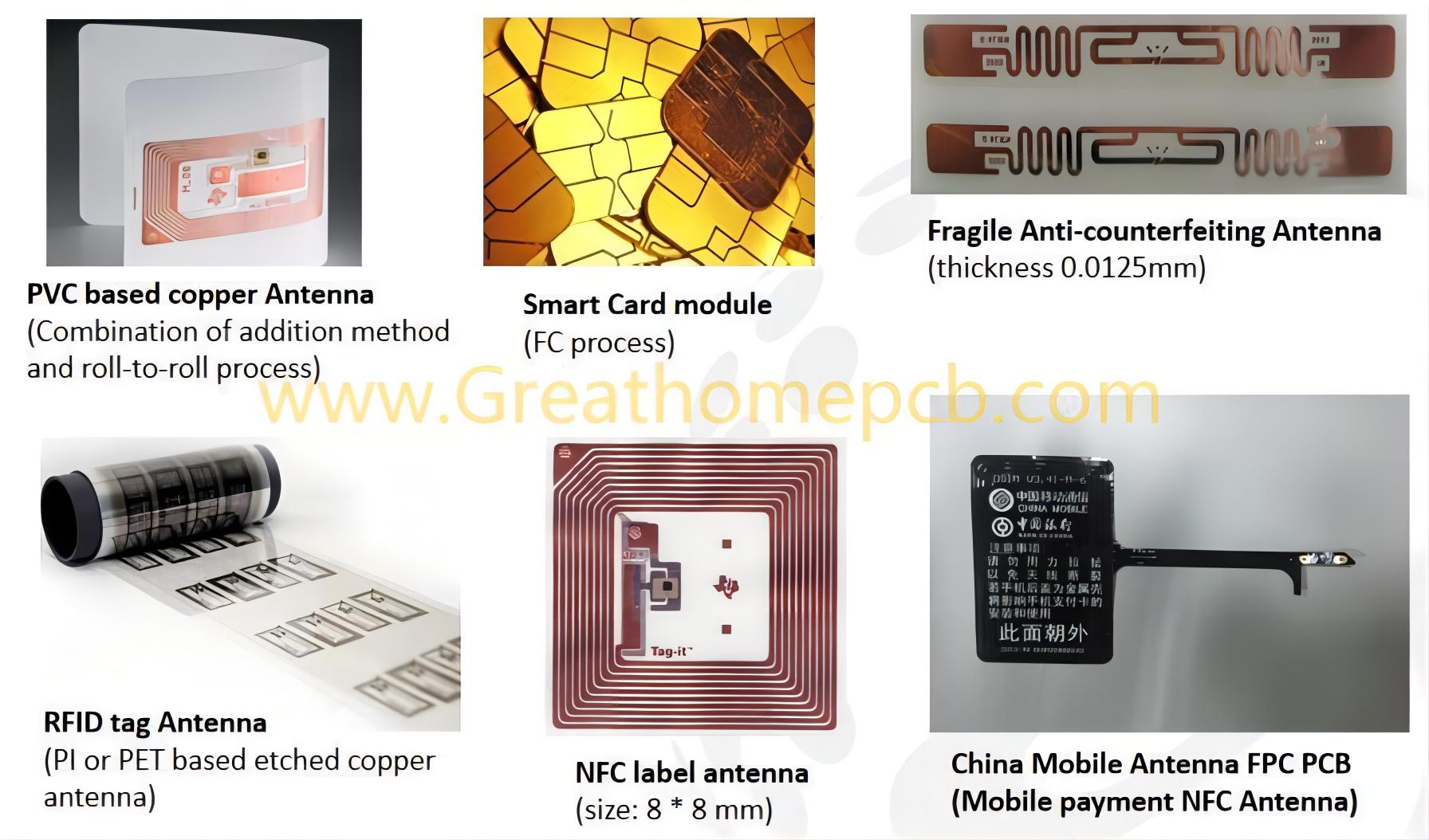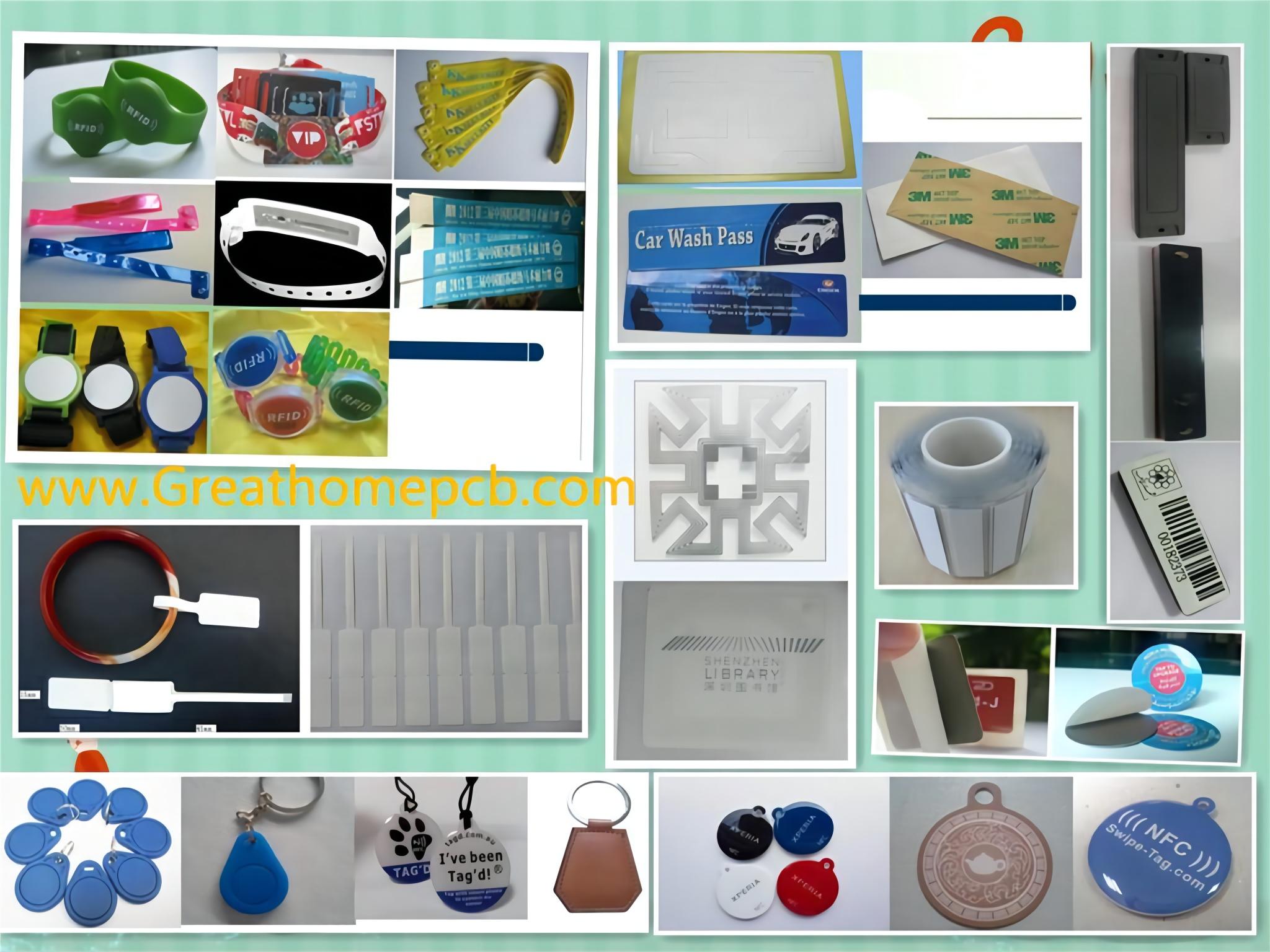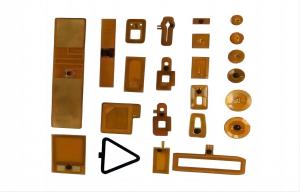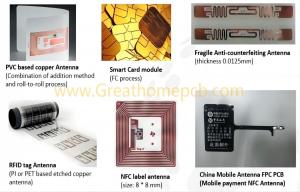Flexible Printed Circuit Board (FPCB) is a kind of printed circuit board with high reliability, excellent flexibility and light weight, which can place parts and circuits and complete electrical functions after a series of production processes based on PI or PET material. It has the characteristics of high wiring density, light weight, thin thickness and good flexible.
FPC flexible electronic label, FPC small size NFC label, RFID flexible circuit board, FPC metal resistant label using copper material, copper is more stable, etching resistance, can produce more stable frequency, smaller size Antenna.
Traditional etched aluminum antenna cannot be made smaller antenna due to its material property limitation. Compared with copper material property, copper is more stable and etchable, so it can make antennas with more stable frequency and smaller size.
The manufacture of small precision antenna has always been a big problem in the electronic tag industry. The use of copper antenna makes this problem solved smoothly.
We use PI/PET material and etching copper technology as the basis, can effectively solve the NFC electronic tag, RFID electronic tag miniaturization, It has the characteristics of high distance, stable performance, small size and structure, high temperature resistance and so on, and the electronic tag made by COB process has been tested and verified for a long time, and its stability has been recognized by the whole industry. This packaging process can also be used in different harsh environments, and can meet different packaging forms in the later stage.
FPC material RFID electronic tag can encapsulate self-adhesive paste, metal resistant material, FPC small size NFC tag, RFID flexible circuit board, FPC metal resistant tag its antenna size can be 8*15mm, diameter 8mm, 8.7*8.7mm, 5.4*19mm, 8*18.5mm, 4*16.5 mm, diameter 15mm, 4*16.5 mm, 9*21mm and other sizes, we can also according to customer requirements customized (OEM/ODM) it.
RFID/NFC Electronic tag products using RFID/NFC Smart Antenna PCB have been widely used in file management, production line management, warehouse management, automotive logistics, power inspection, clothing inventory, brand security, production line data collection, toys, automobile manufacturing, medical, and other fields. With continuous technology research and development and innovation, we combine strong label design ability with RF technology, materials and customer needs perfectly to meet the customized products and services of different customers.
If you are looking for a reliable RFID/NFC Smart Antenna PCB product partner in China, please don’t hesitate to contact us.
RFID Electronic tag technology, also known as RFID (Radio FrequencyIdentification), is a non-contact automatic identification technology. The information stored in the RFID electronic tag can be read by Radio waves emitted by sensors within a distance of a few centimeters to a few meters. Identify the identity of items, people and appliances represented by RFID electronic tags.
RFID electronic tag technology and other automatic identification technology, such as compared with bar code identification technology, has the following characteristics: RFID electronic tag reader through mud, dirt, oil, wood, cement, plastic, steam and other non-metallic materials to read the tag, not necessarily direct contact with the tag; RFID electronic label data storage capacity is large, the label data can be encrypted, updated at any time;
RFID electronic tags achieve "contactless", do not need linear scanning operation, fast reading and writing speed, reading distance is large; RFID electronic tags are small in size, easy to package and diverse in shape. RFID electronic tag service life can be more than 10 years, read and write 100,000 times, no mechanical wear, no mechanical failure; RFID electronic tags are unique in number and can be added with security identification codes.
RFID performance characteristics:
1. Quick scan.
RFID reader can identify and read several RFID tags at the same time.
2. Miniaturization and diversification of shape.
RFID is not limited by size and shape in reading, and does not need to match the fixed size and printing quality of paper for reading accuracy. In addition, RFID tags can be miniaturized and diversified forms of development, to be applied to different products.
3. Pollution resistance and durability.
While traditional barcodes are based on paper, which makes them vulnerable to contamination, RFID is highly resistant to substances such as water, oil and chemicals. In addition, as bar codes are attached to plastic bags or outer cartons, they are particularly vulnerable to damage; RFID labels store data in chips, so they can be protected from contamination.
4. Reusable.
Today's bar code can not be changed after printing, RFID tags can be repeated to add, modify, delete the data stored in THE RFID volume label, convenient information update.
5. Penetrative and unobstructed reading.
When covered, RFID is able to penetrate non-metallic or opaque materials such as paper, wood and plastic, and is capable of penetrating communication. The bar code scanner must be at close range and free of objects to read the bar code.
6. Large memory capacity of data.
A one-dimensional bar code has a capacity of 50Bytes, a two-dimensional bar code has a maximum capacity of 2 to 3000 characters, and an RFID has a maximum capacity of several MegaBytes. With the development of memory carrier, data capacity is also increasing. In the future, the amount of data that objects will need to carry will increase, and the need to expand the capacity of labels will increase accordingly.
7. Security.
Because RFID carries electronic information, its data content can be protected by password, so that its content is not easy to be forged and altered.
RFID has attracted much attention because of its features such as remote reading and high storage capacity. It can not only help an enterprise greatly improve the efficiency of goods and information management, but also enable sales enterprises and manufacturing enterprises to connect, so as to receive feedback information more accurately, control demand information and optimize the whole supply chain.
NFC (Near field wireless communication technology) is developed on the basis of RFID. NFC is not much different from RFID in essence, which is based on the transmission of signals between two objects in close geographical locations.
However, there are differences between NFC and RFID.
NFC technology adds point-to-point communication function, which can quickly establish P2P (point-to-point) wireless communication between Bluetooth devices. NFC devices find each other and establish communication connections. The two devices of P2P communication are peer, while the two devices of RFID communication are master-slave.
There are other technical details:
Compared with RFID technology, NFC has some characteristics such as short distance, high bandwidth and low energy consumption. Details:
1. NFC is only limited to 13.56MHz band! RFID has low frequency (125KHz to 135KHz), high frequency (13.56mhz) and uHF (860MHz to 960MHz).
2. Working effective distance: NFC (less than 10cm, so has a high security), RFID distance from a few meters to dozens of meters!
3. Because also works at 13.56MHz, NFC is compatible with the existing contactless smart card technology, so many manufacturers and related groups support NFC, while RFID standards are more, more complex unified (estimated is not possible to unify), can only be in a special industry with special needs, the corresponding technical standards!
4. Application: RFID is more applied in production, logistics, tracking, asset management, while NFC plays a huge role in access control, public transportation, mobile payment and other fields.

Differences between NFC and RFID:
1. NFC integrates contactless card reader, contactless card and point-to-point function into a single chip, while RFID must be composed of reader and tag.
RFID can only realize information reading and judgment, while NFC technology emphasizes information interaction. Informally, NFC is an evolution of RFID, where the two parties can exchange information in close proximity. NFC mobile phone built-in NFC chip, constitute a part of the RFID module, can be used as RFID passive tag for payment; It can also be used as RFID reader for data exchange and collection, and can also be used for data communication between NFC mobile phones.
2. The transmission range of NFC is smaller than that of RFID. The transmission range of RFID can reach several meters or even tens of meters.
3. Different directions of application. While NFC looks more at consumer electronics devices communicating with each other, active RFID is better at identifying them over long distances.
With the popularity of the Internet, mobile intelligent terminal as the Internet the most direct, will cause a technological revolution, such as bluetooth, USB, GPS standard, NFC will become the most important standard, the mobile phone in the future through the NFC technology, mobile payment, watch movies, take the subway can be implemented, will be in our daily life play a more important role.
Printing method of RFID/NFC electronic tag Antenna PCB:
RFID electronic tag antenna manufacturing commonly used technical methods are: Etching, Electroplating and Direct Printing (conductive ink printing Brush method), all belong to the antenna printing technology. At present, etching and electroplating are the main methods at home and abroad, and direct printing is a newly emerging and studied printing technology.
1). Etching method. Also known as printing etching, or reduced to printing.
First in a base carrier (such as plastic) covered with a layer of 20um ~ 25um thick copper or aluminum, in addition to the production of an antenna positive screen printing plate, with the screen printing method will be printed on the surface of the corrosion inhibitor of copper or aluminum, protect the following copper or aluminum erosion; The copper or aluminum that is not covered by the corrosion inhibitor will be dissolved by the corrosion agent, exposing the base to become the spacing line of the antenna electrical route; Finally, the anti-corrosion film is removed with the coating solution, and then the antenna is made.
2). Electroplating method. Also known as printing and electroplating, or addition printing.
The substrate is coated by printing with a thin layer of catalytic ink (a few microns) in the shape of a positive antenna. The special ink contains metal particles. After printing, the printed material goes through an electroplating process in which copper is coated on the material and only attaches to the pattern formed by the ink. The electroplating process continues until the amount of copper deposited on the material is thick enough to make it conductive enough to form the antenna.
3). Direct printing method.
Direct printing method is to directly use conductive ink on the insulating base (film, paper, etc.) to print conductive lines, forming antennas and circuits. The reason why the RFID electronic tag antenna printed by direct printing method is stronger than the RFID electronic tag antenna made by traditional method
The characteristics and advantages of the line, mainly depends on the characteristics of conductive ink and the perfect combination of printing technology.
Conductive ink, also known as conductive adhesive, conductive silver paste, is a special ink that allows current to flow, composed of dispersed fine conductive particles and conductive polymers. Printing on flexible or hard substrates can be made into printed circuit, play the role of wire, antenna and resistance, to a large extent determines the RFID printing antenna impedance, which is an important parameter related to the performance of RFID antenna.
RFID/NFC Application field and Application Description:
1. Logistics
Logistics warehousing is one of the most potential application fields of RFID, UPS, DHL, Fedex and other international logistics giants are actively testing RFID technology, in order to improve their logistics capacity in the future large-scale application. The application process includes: goods tracking in the logistics process, automatic information collection, warehouse management application, port application, postal parcels, express and so on.
2. Retail
by Wal-mart, Metro and other large supermarkets to promote THE RFID application, can bring retail including reducing labor costs, visibility of goods, reduce the loss caused by goods out of stock, reduce the phenomenon of goods theft and so on. The application process includes: real-time statistics of sales data, replenishment, anti-theft and so on.
3. Manufacturing industry
Used in the production process of production data real-time monitoring, quality tracking, automatic production, personalized production and so on. The application is more urgent in the field of valuable and precise goods production.
4. Garment Industry
It can be applied to automatic garment production, warehouse management, brand management, single product management, channel management and other processes. With the reduction of label price, this field will have great application potential. However, in the application, you must carefully consider how to protect personal privacy.
5. Medical industry
Can be applied to dry hospital medical equipment management, patient identification, infant anti-theft and other fields. The healthcare industry is less sensitive to the cost of RFID/NFC tags, so it will be one of the areas where RFID will be used.
6. Identification
RFID technology is widely used as an identity card for thousands of people because it is naturally fast to read and difficult to counterfeit. For example, the electronic passport project is now carried out in various countries around the world, China's second generation id card, student id card and other electronic documents.
7. Anti-counterfeiting
RFID technology has the characteristics of being difficult to forge, but how to apply it to anti-counterfeiting still needs the active promotion of the government and enterprises. Can be applied in the field including: valuables (tobacco, alcohol, medicine) security, ticket security, etc.
8. Asset Management
All kinds of assets (valuable or large amount of similar or dangerous goods, etc.) with the decrease of the price of electronic tags, almost all items can be involved.
9. Transportation
There have been many successful cases such as high-speed no-stop, taxi management, bus hub management and railway locomotive identification. Great application potential.
10. Food
Freshness management of fruits, vegetables, fresh food, etc. Because food, fruits, vegetables and fresh have too much water content, it will affect the normal electronic label recognition, so the application in this field will make innovations in label design and application mode.
11. Animal Recognition
Training animals, livestock, pets and other identification management, animal disease tracking, livestock personalized breeding, etc.
12. Library
Bookstore, library, publishing house and other applications. Can greatly reduce the inventory of books, management time, can realize automatic rent, borrow, return books and other functions. In the United States, Europe, Singapore and other library applications have been successful cases.
13. Automobile
Manufacturing, theft, location, car keys, It can be applied to automobile automation, personalized production, automobile anti-theft, automobile positioning, and can be used as a high security car key.
14. Aviation
Make passenger tickets, baggage and parcel tracking.
It can be used in aircraft manufacturing, aircraft parts maintenance and quality tracking, passenger ticket, fast boarding, passenger package tracking.
15. Military affairs
Identification and tracking of ammunition, guns, supplies, personnel, trucks, etc.
16. Others: Access control, attendance, electronic inspection, one card, consumption, electronic parking lot, etc.





